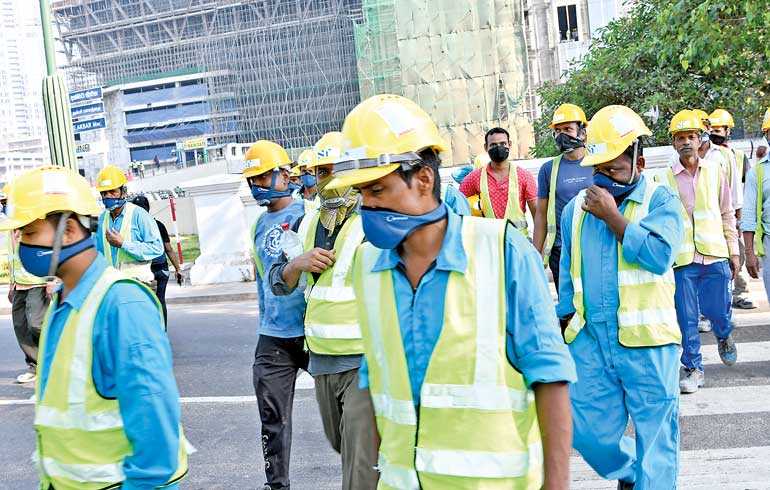Saturday Apr 19, 2025
Saturday Apr 19, 2025
Wednesday, 18 March 2020 00:00 - - {{hitsCtrl.values.hits}}

The COVID-19 is not just a public health emergency but it is also an economic shock which has caused global economic disruptions through finance, trade and people channels – Pic by Shehan Gunasekara
At the dawn of 2020, experts thought that the world economy had finally bottomed out from the 2008 global financial crisis. In January 2020, the IMF projected that global growth would rise from 2.9% in 2019 to 3.3% in 2020. However, the scenario has changed with the fast spread of COVID-19 in February 2020. Global growth in 2020 will be less than the IMF projection. But whether it will trigger a global recession and what it means for Sri Lanka are the key policy questions today.
From health emergency to global economic crisis?
The world economy was fragile even before COVID-19. The trade war between the US and China, coupled with rising geopolitical tensions, had taken a toll on global trade which had hitherto driven globalisation.
China, the world’s factory, was seeing a hollowing out of manufacturing and off-shoring of manufacturing production in the wake of the trade war and rising wages. Europe was hampered by uncertainties in the Brexit process and weak business investment. Japan, at the frontier of a super aging population and a consumption tax hike, was confronting sluggish growth. All of these were happening when India was slowing with distress in rural areas, weighed down by the lingering effects of demonetarisation and the general sales tax. Other developing economies, with rising debt levels and limited fiscal space, were experiencing a bout of risk aversion by investors. 
Then came the unexpected global spread of COVID-19 – a rapidly-moving highly contagious infection originating in China. It has been rightly declared a pandemic by the World Health Organization (WHO) having affected 146 countries, infecting over 150,000 people and causing more than 6000 deaths (16 March 2020). The rapid transmission of the disease is linked to globalisation of the world economy, the advent of truly global travel and human mobility particularly between airports. It is putting an enormous strain on health care systems and disaster risk management.
The COVID-19 is not just a public health emergency but it is also an economic shock which has caused global economic disruptions through finance, trade and people channels. It has hit global financial markets, reduced valuations, tumbled stock markets and caused volatile capital flows. It has disturbed global supply chains, forcing multinational companies to reduce or temporarily close assembly and factories. In turn, this is affecting second-tier suppliers, demand for goods and services and global trade.
Urban shut downs and international travel restrictions are halting people movement on an unprecedented scale. Business confidence, consumer activity and daily life have altered. The risk of significant unemployment, income inequality and poverty, both within and between economies, is looming large on the horizon.
Scenarios for global growth in 2020-2021
It is still too early to assess the full economic impact of COVID-19. Data is inadequate and existing forecasting models are not adequately specified to analyse the disruption from the pandemic. The IMF will update its global economic forecasts during the Spring Meetings in mid-April 2020, which are being held virtually for the first time.
Nonetheless, there is a growing consensus among economists that global growth in 2020 will be lower than the figure for 2019. Two scenarios are possible at this stage with the depth of economic downturn depending on the effectiveness in containing the pandemic:
• Scenario 1: a short outbreak and a limited global economic impact. The global spread of COVID-19 is checked within a few months through measures such as large-scale virus testing, social distancing, quarantine procedures and medical treatment. Ultimately, a vaccine is successfully developed and readily made available. Under scenario 1, global growth in 2020 may be in the range of 2.3-2.5%. Some upturn in global growth may also be expected in 2021. Nonetheless, this scenario will fall within the practical definition of a recession by economists as two consecutive quarters of fall in a country's real (inflation adjusted) gross domestic product (GDP).
A coordinated global response, backed by national efforts, is crucial to tackle the pandemic. Addressing public health needs is the first priority. The 70-year old WHO has been slow to reform itself and faced funding cuts. But, as the only global health agency in the UN system, it urgently needs increased financial resources to support economies engulfed by COVID-19 and modernisation of the institution over time
• Scenario 2: A long outbreak and a prolonged global economic impact. COVID-19 continues to spread internationally at a rapid pace, the measures are partially successful in containing the disease and it takes longer than expected to develop a vaccine. Under scenario 2, global growth in 2020 could slip to a range of 1.0-1.5% and remain subdued in 2021. According to the suggested definition, this would constitute a lengthy recession.
A coordinated global response, backed by national efforts, is crucial to tackle the pandemic. Addressing public health needs is the first priority. The 70-year old WHO has been slow to reform itself and faced funding cuts. But, as the only global health agency in the UN system, it urgently needs increased financial resources to support economies engulfed by COVID-19 and modernisation of the institution over time.
With a severe downturn likely, a complementary priority is for economies to spend notable sums to protect vulnerable households. They should also prepare fiscal measures including transfers and backstops to financial institutions. The US Federal Reserve has cut interest rates back to zero and reintroduced the bond-buying program it used to tackle the 2008 global financial crisis. The Trump Administration and Congress are in the process of negotiating an economic stimulus package. The European Central Bank introduced a modest stimulus package including new cheap loans to banks but did not cut interest rates. These efforts are laudable but much below the spending levels and close international coordinated action undertaken to tackle the 2008 global financial crisis.
Implications for Sri Lankan growth
At the time of the IMF Mission visit to Sri Lanka in January 2020, the country was on a recovery trajectory from the Easter Sunday attacks and the IMF projected better GDP growth of 3.7% in 2020. A part of that growth was attributed to change of political regime. Business confidence and investment along with public infrastructure investment were thought likely to boost growth. Some commentators also felt that the new tax measures and financial support to SMEs were useful at least in the short-term. And the world economy appeared to be looking up offering the prospect of export growth, more inward investment into Sri Lanka and higher tourist arrivals. Parliamentary Elections were announced for 25 April with the SLPP looking to gain a majority of seats.
At the time of the IMF Mission visit to Sri Lanka in January 2020, the country was on a recovery trajectory from the Easter Sunday attacks and the IMF projected better GDP growth of 3.7% in 2020. However, since then COVID-19 has emerged as a public health and macroeconomic risk for Sri Lanka. While some 28 cases have been recorded to date, there are signs of the adverse economic impact in terms of reduced numbers of tourists, capital outflows, waning business confidence and falling export orders. A temporary COVID-19 outbreak would have a modest impact on Sri Lanka’s growth in 2020. Forecasting growth in a small open economy like Sri Lanka is a difficult exercise. An educated guess suggests that a temporary outbreak might lower Sri Lankan growth to 2019 levels, which is expected to be 2.7% or thereabouts. But a prolonged outbreak obviously creates more stress for the Sri Lankan economy and would mean lower growth than the temporary outbreak. It is encouraging that Sri Lanka has launched a strong public health emergency response and is supportive of a SAARC initiative to contain COVID-19. A similar initiative to bolster the macroeconomy and protect vulnerable households is also needed in consultation with international agencies and aid donors
However, since then COVID-19 has emerged as a public health and macroeconomic risk for Sri Lanka. While some 28 cases have been recorded to date, there are signs of the adverse economic impact in terms of reduced numbers of tourists, capital outflows, waning business confidence and falling export orders. A temporary COVID-19 outbreak would have a modest impact on Sri Lanka’s growth in 2020. Forecasting growth in a small open economy like Sri Lanka is a difficult exercise.
An educated guess suggests that a temporary outbreak might lower Sri Lankan growth to 2019 levels, which is expected to be 2.7% or thereabouts. But a prolonged outbreak obviously creates more stress for the Sri Lankan economy and would mean lower growth than the temporary outbreak. It is encouraging that Sri Lanka has launched a strong public health emergency response and is supportive of a SAARC initiative to contain COVID-19. A similar initiative to bolster the macroeconomy and protect vulnerable households is also needed in consultation with international agencies and aid donors.
(The writer is Executive Director, Lakshman Kadirgamar Institute of International Relations and Strategic Studies.)